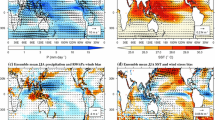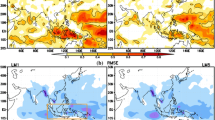Abstract
In this study the predictability of northeast monsoon (Oct–Nov–Dec) rainfall over peninsular India by eight general circulation model (GCM) outputs was analyzed. These GCM outputs (forecasts for the whole season issued in September) were compared with high-resolution observed gridded rainfall data obtained from the India Meteorological Department for the period 1982–2010. Rainfall, interannual variability (IAV), correlation coefficients, and index of agreement were examined for the outputs of eight GCMs and compared with observation. It was found that the models are able to reproduce rainfall and IAV to different extents. The predictive power of GCMs was also judged by determining the signal-to-noise ratio and the external error variance; it was noted that the predictive power of the models was usually very low. To examine dominant modes of interannual variability, empirical orthogonal function (EOF) analysis was also conducted. EOF analysis of the models revealed they were capable of representing the observed precipitation variability to some extent. The teleconnection between the sea surface temperature (SST) and northeast monsoon rainfall was also investigated and results suggest that during OND the SST over the equatorial Indian Ocean, the Bay of Bengal, the central Pacific Ocean (over Nino3 region), and the north and south Atlantic Ocean enhances northeast monsoon rainfall. This observed phenomenon is only predicted by the CCM3v6 model.
















Similar content being viewed by others
References
Acharya N, Kar S.C, Kulkarni M.A, Mohanty U.C and Sahoo L.N. (2011a) Multi-model ensemble schemes for predicting northeast monsoon rainfall over peninsular India. J. Earth Syst. Sci. 120, No. 5, October 2011, pp. 795–805.
Acharya, N, Kar S.C, Mohanty U.C, Kulkarni M.A, Dash S.K. (2011b). Performance of GCMs for seasonal prediction over India—a case study for 2009 monsoon. Theor. Appl. Climatol. 105:505–520.
Balachandran S, Asokan R. and Sridharan S. (2006) Global surface temperature in relation to northeast monsoon rainfall over Tamil Nadu. J Earth Syst Sci, 115, 3, 349–362, doi:10.1007/BF02702047.
Kang I.S, Lee J, and Park C.K. (2004). Potential predictability of summer mean precipitation in a dynamical seasonal prediction system with systematic error correction. J. Climate, 17:834–844.
Kripalani R.H, and Kumar P. (2004) Northeast monsoon rainfall variability over south peninsular India vis-à-vis the Indian Ocean dipole mode. Int. J. Climatol., 24, 1267–1282.
Krishnamurti T.N, Kishtawal C.M, Zhang Z, LaRow T.E, Bachiochi D.R, et al. (1999) Improved weather and seasonal climate forecasts from multi-model superensemble. Science 285:1548–1550.
Kumar P, Rupa Kumar K, Rajeevan M., Sahai A.K. (2007) On the recent strengthening of the relationship between ENSO and northeast monsoon rainfall over South Asia. Clim. Dyn. 28, 649–660.
Lee, D.E, De Witt D.G.A. (2009). New Hybrid Coupled Forecast System Utilizing the CFSSST,2009 Forecasts [http://portal.iri.columbia.edu/portal/server.pt/gateway/PTARGS_0_4972_5734_0_0_18/NOAAabstract2009].
Lorenz E.N. (1956) Empirical orthogonal functions and statistical weather prediction. Technical report, Statistical Forecast Project Report 1, Dept. of Meteor., MIT, 1956. 49 pp.
Nageswara Rao, G. (1999) Variations of the SO relationship with summer and winter monsoon rainfall over India. 1872–1993. J. Climate, 12, 3486–3495.
Nayagam L.R, Janardanan R, Ram Mohan H.S. (2009) Variability and teleconnectivity of northeast monsoon rainfall over India. Global and Planetary Change 69 (2009) 225–231.
Pacanowski R.C, Griffes S.M (1998). MOM 3.0 manual. NOAA/Geophysical Fluid Dynamics Laboratory, Princeton, 608 pp.
Palmer T.N, Alessandri A, Andersen U, Cantelaube P, Davey M, et al. (2004) Development of a European multi-model ensemble system for seasonal to interannual prediction (DEMETER). Bull Am Meteorol Soc 85:853–872.
Pant, G.B., and Rupa Kumar, K. (1997) Climates of South Asia. John Wiley & Sons, Chichester, 320 pp.
Peng P, Kumar A, Wang W (2011). An analysis of seasonal predictability in coupled model forecasts Clim Dyn 36:637–648. doi:10.1007/s00382-009-0711-8.
Rajeevan M, Bhate J, Kale J, Lal B (2006) High resolution daily gridded rainfall data for the Indian region: Analysis of break and active monsoon spells. Curr. Sci., 91, 296–306.
Randall, D., Ed, (2000) General Circulation Model Development: Past, Present and Future. Academic Press, 781 pp.
Roeckner E, and Coauthors, 1996. The atmospheric general circulation model ECHAM4: model description and simulation of present-day climate. Max-Planck-Institutitute fur Meteorologie Rep. 218, Hamburg, 90 pp.
Saha S, Nadiga S, Thiaw S, Wang J, Wang W, Zhang Q, Van Den Dool H.M, Pan H.L, Moorthi S, Behringer D, Stokes D, Pena M, Lord S, White G, Ebisuzaki W, Peng P and Xie P. 2006. The NCEP climate forecast system. J. Clim 19:3483–3517.
Saha S, Shrinivas Moorthi, Xingren Wu, Jiande Wang, Sudhir Nadiga, Patrick Tripp, Hua-Lu Pan, David Behringer, Yu-Tai Hou, Hui-ya Chuang, Mark Iredell, Michael Ek, Jesse Meng, Rongqian Yang.2011. : The NCEP Climate Forecast System Version 2. To be submitted to the Journal of Climate (http://cfs.ncep.noaa.gov/cfsv2.info/CFSv2_paper.pdf).
Singh N, and Sontakke N.A (1999) On the variability and pre-diction of the rainfall in the post-monsoon season over India. Int. J. Climatol., 19, 300–309.
Singh A, Acharya N, Mohanty UC, Robertson AW, Mishra G (2012) On the predictability of Indian summer monsoon rainfall in general circulation model at different lead time. Dynamics of Atmospheres and Oceans 58 (2012) 108–127.
Smith T.M, Reynolds R.W, Thomas C.P, and Lawrimore Jay. (2008) Improvements to NOAA’s Historical Merged Land-Ocean Surface Temperature Analysis (1880–2006). J. Climate, 21, 2283–2296.
Sreekala P.P,Vijaya Bhaskara Rao S, Rajeevan M (2012) Northeast monsoon rainfall variability over south peninsular India and its teleconnections. Theor Appl Climatol 108:73–83. doi:10.1007/s00704-011-0513-x.
Tippette M.K, Alessandra G (2006) Potentially Predictable Components of African Summer Rainfall in an SST-Forced GCM Simulation J. Climate, 19:3133–3144.
Walker G.T (1924) Correlation in seasonal variations of weather. IX, A further study of world weather. IMD Memo. XXIV, Part IX, pp. 75–131.
Wilks D.S (1995) Statistical Methods in Atmospheric Sciences. Academic press, California, USA. pp. 169–390.
Willmott C.J (1982) Some comments on the evaluation of model performance. Bull. Am. Meteorol. Soc. 63:1309–1313.
Zubair L, (2002) El Niño–Southern Oscillation influences on rice production in Sri Lanka. Int. J. Climatol., 22, 242–250.
Zubair L, Ropelewski C.F (2006) The strengthening relationship between ENSO and northeast monsoon rainfall over Sri Lanka and Southern India. J. Climate 19, 1567–1575.
Acknowledgments
This research is supported by the Government of India funded project “Development and Application of Extended Range Forecast System (ERFS) for Climate Risk Management in Agriculture”. India Meteorological Department (IMD) is acknowledged for providing observed gridded rainfall datasets. The model datasets used in this study have been provided by the International Research Institute of Climate and Society (IRI), USA. The computing for the GCM simulations performed by the IRI and was partially provided by a grant from the NCAR Climate System Laboratory (CSL) program to the IRI. The IRI represents a cooperative agreement between the US National Oceanic and Atmospheric Administration (NOAA) Office of Global Programs and Columbia University. The authors are very much grateful to Mr Anil Singh for his assistance in improving the figures of the manuscript. Sincere thanks to both of the reviewers for their expert comments which enhanced the quality of the manuscript.
Author information
Authors and Affiliations
Corresponding author
Rights and permissions
About this article
Cite this article
Nair, A., Acharya, N., Singh, A. et al. On the Predictability of Northeast Monsoon Rainfall over South Peninsular India in General Circulation Models. Pure Appl. Geophys. 170, 1945–1967 (2013). https://doi.org/10.1007/s00024-012-0633-y
Received:
Revised:
Accepted:
Published:
Issue Date:
DOI: https://doi.org/10.1007/s00024-012-0633-y




